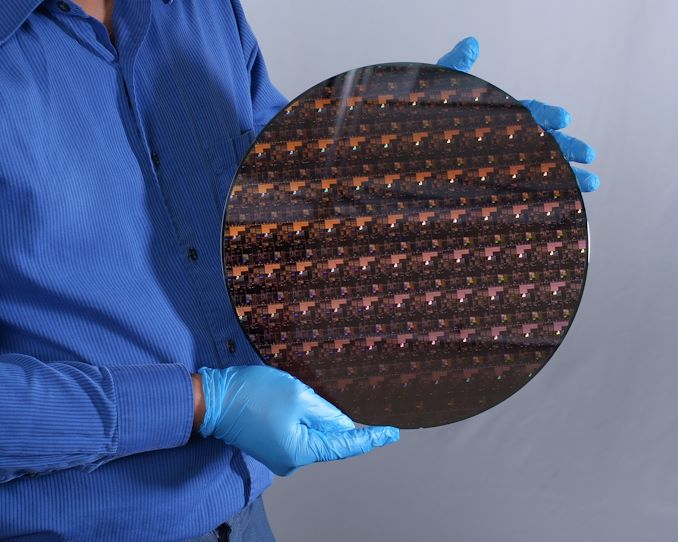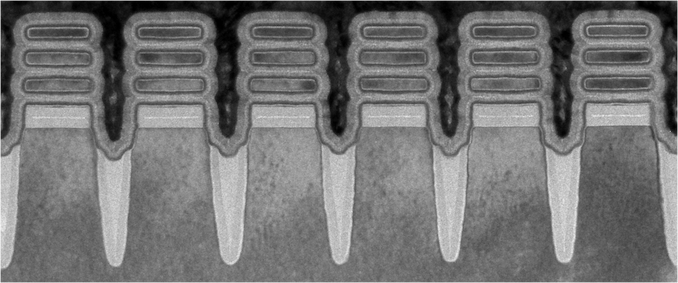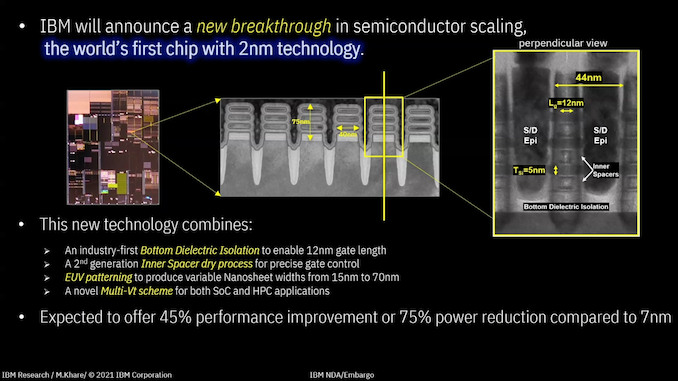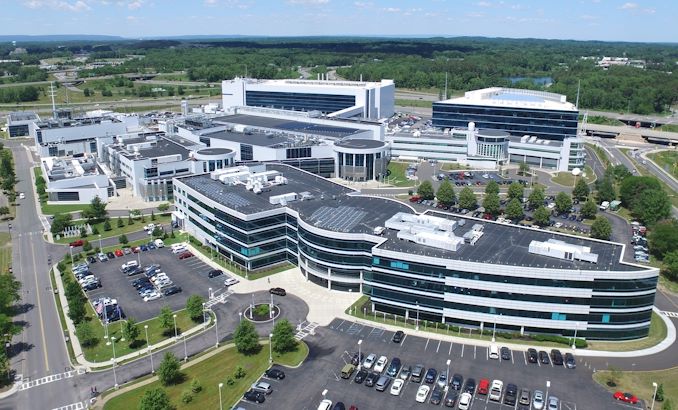IBM Creates First 2nm Chip
by Dr. Ian Cutress on May 6, 2021 6:00 AM EST
Every decade is the decade that tests the limits of Moore’s Law, and this decade is no different. With the arrival of Extreme Ultra Violet (EUV) technology, the intricacies of multipatterning techniques developed on previous technology nodes can now be applied with the finer resolution that EUV provides. That, along with other more technical improvements, can lead to a decrease in transistor size, enabling the future of semiconductors. To that end, Today IBM is announcing it has created the world’s first 2 nanometer node chip.
Names for Nodes
Just to clarify here, while the process node is being called ‘2 nanometer’, nothing about transistor dimensions resembles a traditional expectation of what 2nm might be. In the past, the dimension used to be an equivalent metric for 2D feature size on the chip, such as 90nm, 65nm, and 40nm. However with the advent of 3D transistor design with FinFETs and others, the process node name is now an interpretation of an ‘equivalent 2D transistor’ design.
Some of the features on this chip are likely to be low single digits in actual nanometers, such as transistor fin leakage protection layers, but it’s important to note the disconnect in how process nodes are currently named. Often the argument pivots to transistor density as a more accurate metric, and this is something that IBM is sharing with us.
Transistor Density
Today’s announcement states that IBM’s 2nm development will improve performance by 45% at the same power, or 75% energy at the same performance, compared to modern 7nm processors. IBM is keen to point out that it was the first research institution to demonstrate 7nm in 2015 and 5nm in 2017, the latter of which upgraded from FinFETs to nanosheet technologies that allow for a greater customization of the voltage characteristics of individual transistors.
IBM states that the technology can fit ’50 billion transistors onto a chip the size of a fingernail’. We reached out to IBM to ask for clarification on what the size of a fingernail was, given that internally we were coming up with numbers from 50 square millimeters to 250 square millimeters. IBM’s press relations stated that a fingernail in this context is 150 square millimeters. That puts IBM’s transistor density at 333 million transistors per square millimeter (MTr/mm2).
For comparison:
| Peak Quoted Transistor Densities (MTr/mm2) | ||||
| AnandTech | IBM | TSMC | Intel | Samsung |
| 22nm | 16.50 | |||
| 16nm/14nm | 28.88 | 44.67 | 33.32 | |
| 10nm | 52.51 | 100.76 | 51.82 | |
| 7nm | 91.20 | 237.18* | 95.08 | |
| 5nm | 171.30 | |||
| 3nm | 292.21* | |||
| 2nm | 333.33 | |||
| Data from Wikichip, Different Fabs may have different counting methodologies * Estimated Logic Density |
||||
As you can tell, different foundries have different official names with a variety of densities. It’s worth noting that these density numbers are often listed as peak densities, for transistor libraries where die area is the peak concern, rather than frequency scaling – often the fastest parts of a processor are half as dense as these numbers due to power and thermal concerns.
With regards the movement to Gate-All-Around / nanosheet transistors, while not explicitly stated by IBM, images show that this new 2nm processor is using a three-stack GAA design. Samsung is introducing GAA at 3nm, while TSMC is waiting until 2nm. Intel by contrast, we believe, will introduce some form of GAA on its 5nm process.
IBM’s 3-stack GAA uses a cell height of 75 nm, a cell width of 40 nm, and the individual nanosheets are 5nm in height, separated from each other by 5 nm. The gate poly pitch is 44nm, and the gate length is 12 nm. IBM says that its design is the first to use bottom dieletric isolation channels, which enables the 12 nm gate length, and that its inner spacers are a second generation dry process design that help enable nanosheet development. This is complimented by the first use of EUV patterning on the FEOL parts of the process, enabling EUV at all stages of the design for critical layers.
Users might be wondering why we’re hearing that IBM is the first to a 2nm chip. IBM is one of the world’s leading research centers on future semiconductor technology, and despite not having a foundry offering of their own, IBM develops IP in collaboration with others for their manufacturing facilities. IBM sold its manufacturing to GlobalFoundries with a 10 year partnership commitment back in 2014, and IBM also currently works with Samsung, and recently announced a partnership with Intel. No doubt the latter two will be partnering with IBM on some level around this new development for its viability in their own production chain.
No details on the 2nm test chip have been provided, although at this stage it is likely to be a simplified SRAM test vehicle with a little logic. The 12-inch wafer images showcase a variety of different light diffractions, which likely points to a variety of test cases to affirm the viability of the technology. IBM says that the test design uses a multi-Vt scheme for high-performance and high-efficiency application demonstrations.
The chip was designed and made at IBM’s Albany research facility, which features a 100,000 sq. ft. clean room. The purpose of this facility is to build on IBM’s expansive patent and licensing portfolio for collaborations with partners.
We have a set of questions with IBM’s experts awaiting response. We also now have an active invitation to go visit, as and when we can travel again.
Related Reading
- IBM and AMD to Advance Confidential Computing
- Hot Chips 2020 Live Blog: IBM z15, a 5.2 GHz Mainframe CPU (11:00am PT)
- IBM & Partners to Fight COVID-19 with Supercomputers, Forms COVID-19 HPC Consortium
- Hot Chips 31 Live Blogs: IBM's Next Generation POWER
- IBM to use Samsung 7nm EUV for Next-Gen POWER and z CPUs
- IBM And Everspin Announce 19TB NVMe SSD With MRAM Write Cache
- TSMC Update: 2nm in Development, 3nm and 4nm on Track for 2022
- Intel’s Manufacturing Roadmap from 2019 to 2029: Back Porting, 7nm, 5nm, 3nm, 2nm, and 1.4 nm














118 Comments
View All Comments
Spunjji - Friday, May 7, 2021 - link
"No, you can't meet my girlfriend, she lives in Canada"Spunjji - Friday, May 7, 2021 - link
In every sense. Your first link is marked SOLVED and the second is a thread and poll that predates AMD's fixes for the issues, and contains dozens of people saying the problems are now resolved for them (or tacitly admitting that they were overclocking when they encountered the issues in the first place).Nice work making sure those links get spread around to as many place as possible though, you're a good little shill.
Peskarik - Saturday, May 8, 2021 - link
If you look at the solution in the first thread, would you call this a solution?I expect a new chip to work at stock settings, and for some people it does not.
I like to tinker, but quite a lot of people do not, they just want their CPUs to work off the bat, I do not think it is too much to ask.
Maybe AMD chips are for enthusiasts, who like to spend days, weeks, or months trying to "stabilize" their systems by changing all kinds of BIOS settings and exchanging everything in their hardware but CPU. I am not one of these, I do not have MBs, different RAMs, PSUs, graphics cards etc lying around.
But I will take my chances on my 5900 now. If I get BSODs and WHEAs in stock BIOS settings I will RMA it immediately.
You have mental problem, quite obviously.
I actually read all 75 pages of that thread so I know what people done and whether they overclocked or not.
You did not, but you assumed things, and called me a shill. :-D
Spunji you are a pathetic nobody. :-D
Spunjji - Tuesday, May 18, 2021 - link
"You have mental problem, quite obviously."Yes, obviously. You are qualified to diagnose this and have definitely had sufficient interactions with me to enable you to do so.
"Spunji you are a pathetic nobody. :-D"
Aren't we all?
Spunjji - Friday, May 7, 2021 - link
Oh boy, it's another "random" commenter who just happened to wonder into a totally unrelated article and whine about AMD bugs. It must be a day ending in a Y.You're claiming to have bought a $550 CPU and then left it lying around without even trying it because of stuff you read online. The options here are that you're a fool, a liar, or both.
Peskarik - Saturday, May 8, 2021 - link
As soon as I open the box I have to go through a return process, if I do not open the box I can return it and get cash back immediately. I know this is hard to understand for you, that some people gather info before they start on a project.Yes, I bought the CPU because I got the chance, they are hard to come by otherwise.
Also, my time is valuable, and I do not want to spend it on "stabilizing" systems. But I will take a leap of faith now and build AMD system, maybe I get lucky and have no WHEA/BSOD/reboots.
Now, sod off.
Beaver M. - Sunday, May 9, 2021 - link
Many people reporting issues coming up after months of running stable, though. Without ever changing anything.Thats ultimately why I decided against it. I am like you. I build and forget for 5 to 6 years. If crap like that turns up makes me mad.
I got warned, I took the warning. Built a transition system now. Not nearly as powerful as the 5950x I planned to buy, but at least its super stable. I guess Ill wait for Alder Lake, or AMD to fix their issues...
Spunjji - Tuesday, May 18, 2021 - link
"I know this is hard to understand for you, that some people gather info before they start on a project."But you're saying you did the research *after* you started on the project...
"Also, my time is valuable, and I do not want to spend it on "stabilizing" systems."
But you're happy to spend it buying things you haven't researched, reading 75-page threads about them before building a system, leaving something you bought in the box, *posting about it on Anandtech* and then flinging insults at me?
Yeah, this all seems super smart and sensible, how dare I question your genius I guess.
Beaver M. - Sunday, May 9, 2021 - link
What is so hard to believe? I was almost in the same position. I would have bought the CPU first (since they were so hard to get) and then get mainboard and the rest.But I read about those issues shortly before I bought. Decided against it after that.
If I had the CPU already here, I would have left it unopened too, instead of wasting more money with a mainboard (and regrettably RAM - which has to be selected specifically with AMD in mind).
Spunjji - Tuesday, May 18, 2021 - link
Why is it so hard to believe this first poster claims to be cautious enough not to build a system because they read a thread, but not cautious enough to read the thread before buying the CPU, and has insufficient time for testing systems but plenty of time to post about systems they haven't built on Anandtech? I dunno really, you tell me. Glad they have you to back them up though, a totally independent account who just happens to do the exact same things in these comment sections.